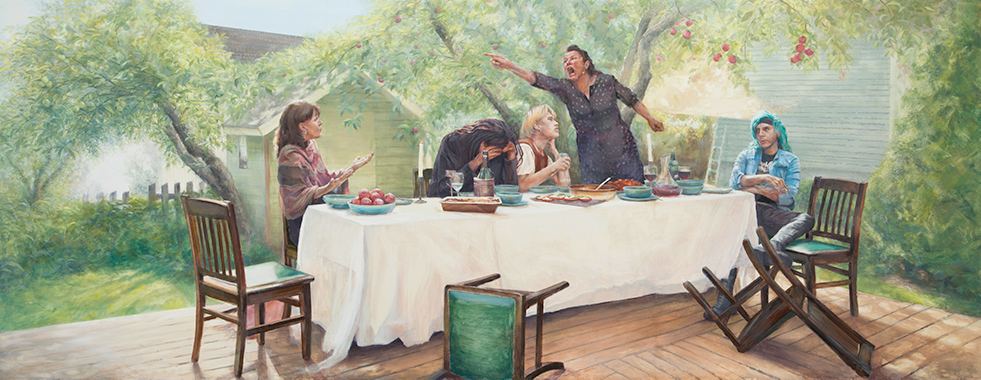Once again, politics and the media are dominated by images of confrontation, polarization, destruction, armed aggression, and human suffering – the whole sorry repertoire of failed attempts at peaceful conflict transformation of which we thought as a thing of the past, at least in Europe. Once again, however, war sidelines peace, war images sideline peace images.
In consequence, in peace research we are once again asked to mobilize what John Paul Lederach calls “the moral imagination” – “the capacity to imagine and generate constructive responses and initiatives that, while rooted in the day-to-day challenges of violence, transcend and ultimately break the grips of those destructive patterns and cycles” (Lederach 2005: 29). Once again, in other words, we are asked to imagine – and to image – peace.
“[W]hat initially meets the eye” – literally – appears destructive and violent, necessitating (but simultaneously rendering difficult) development of the capability of perceiving things beyond what was initially seen (Lederach 2005: 26–27), moving our imagination from war to peace or to peace as a potentiality.

From January to July 2022, we have tried to do just that through the standard channels that academics have at their disposal: publications, events, and conferences.
We are happy about publications of two articles in Media, War & Conflict and Südosteuropa-Mitteilungen, both dealing with photographic representations of post-war Bosnia and Herzegovina. Kosmopolis, the journal of the Finnish Peace Research Association, published our article about active looking as both a mediation tool and a mediator’s skill. Thus, we internationalized our publications by writing in German and Finnish, in addition to English, addressing a wider audience than before.
We presented results of our work at three international conferences: the Early Career Conference of the German Association for Political Science, Photomedia 2022, and the conference of the Finnish International Studies Association. We talked about active looking and the role of visual images in peace processes but also, at Photomedia, about the photography of Richard Mosse – a subject that we pursue together with our friend and colleague Rune Saugmann. Imageandpeace.com represents photography and the visual arts at the HUB for the Study of Hybrid Communication in Peacebuilding, Center for Freedom of the Media, at the University of Sheffield. On May 3, we organized an online event about the visualization of peace. At this occasion, Ana Catarina Pinho and Tiffany Fairey joined us and introduced their work on the peace dimensions of photographic archives and participatory photography, respectively.

From June 6 to August 28, the Finlayson Art Area shows works by fifteen professional artists in the historical cotton mill complex of the city of Tampere. One of these artists is Sebastian Schultz, a visual artist from Tampere who is best known for several large-scale murals depicting the history of Tampere. In his exhibition, Visual Peace, Schultz shows that “peace does not have to be peaceful.” He explores different implementations, colors, and visual methods related to the visualization of peace and presents in his paintings different perspectives on a state called peace.
The center piece of the exhibition, Peace, was commissioned by Imageandpeace.com as part of our series of artistic representations of peace. As always, we provided very little in terms of instruction; we want the artists to illustrate their own visions of peace rather than visualizing ours. Schultz chose to paint a serene summer day that turned into a quarrel at a garden table.
Food is one of the things that might help “create bridges across cultures in conflict,” Cindy Kane suggests, adding that the “dinner table is the place to invite one’s enemies” (2018: 38).
However, even among friends, such peaceful events as dinners and garden parties can escalate and become violent, reminding us of the fragility of social relations. As Schultz shows in his paintings, life is never completely without conflict.

We hope that your summer will be without conflict or, should conflict arise, that you will be able to deal with it peacefully and constructively. We look forward to the second half of the year with participations in the conference Why Remember? Peace, Conflict and Culture in Sarajevo and the 13th Popular Culture and World Politics conference in Magdeburg, among other things.
Hyvää juhannusta!
References
John Paul Lederach, The Moral Imagination: The Art and Soul of Building Peace (Oxford: Oxford University Press, 2005)
Cindy Kane, untitled contribution to Can Art Aid in Resolving Conflicts? 100 Perspectives, edited by Noam Lemelshtrich Latar, Jerry Wind, and Ornat Lev-er (Amsterdam: Frame Publishers, 2018), pp. 38–39
Sebastian Schultz: Visual Peace, handout, Galleria Himmelblau, Finlayson Art Area, Tampere
